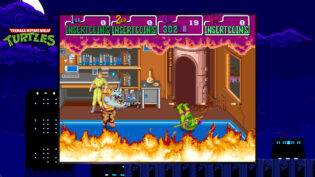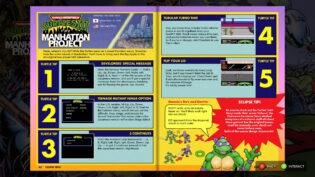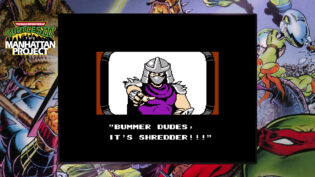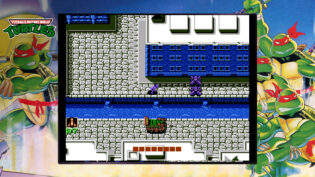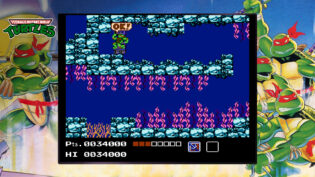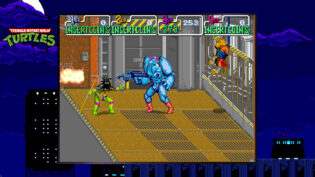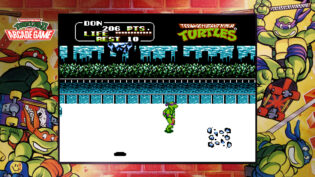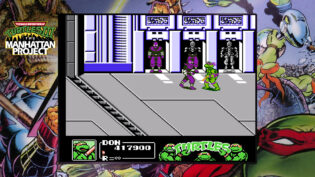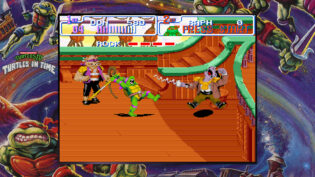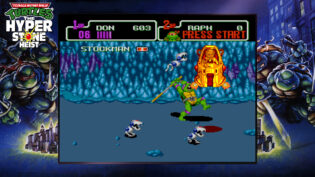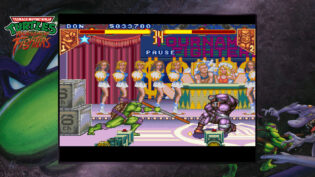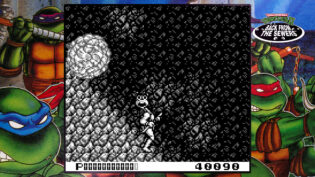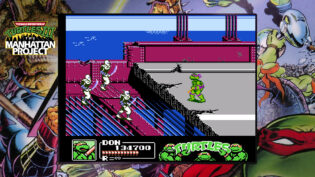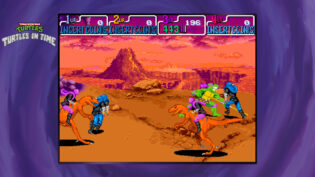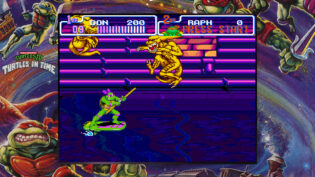O tempora is a series of retrospective posts where I play games from ages before to see if they stood the test of time.
While I suck at fighting games and (to a lesser extent) beat em ups, I grew during the era when they were The Coolest Thing Ever. A local arcade, and I’m still surprised we had one after the crapshow that was Soviet Union, had cabinets with Street Fighter II, Mortal Kombat, Streets of Rage II, Vendetta (Crime Fighters II) and, of course, Teenage Mutant Ninja Turtles. And all of the NES clones came preloaded with X games in one packages where at least one of the classic TMNT games would be included. The TMNT animated series from the 80s were also all the rage and so was the first live action movie. Heck, as a child I even liked the second one.
But it’s been decades, TMNT is no longer as popular as it used to be (though still quite liked), Konami stopped making good games and then any games (and are quite disliked). Curiously, the same year as this Cowabunga Collection released, a genuinely fun new game inspired by the titles from the collection was released – Teenage Mutant Ninja Turtles: Shredder’s Revenge. So, while game preservation is really important, would there be a reason for people who didn’t grow up on the titles from this collection to check it out?
To try to figure it out, let’s start with answering what The Cowabunga Collection is. This is a compilation of all classic Konami developed titles with the license of Teenage Mutant Ninja Turtles from the late 80s to the mid 90s, across several platforms and with different regions presented. If you’ve had experience with similar official collections before, you might know that it is basically a set of game ROMs running in hopefully perfect emulation with little to no changes to how games used to be, unless specifically enabled. There’s one slot save state per game and all games have some sorts of “enhancements”, ranging from just reducing slowdown and sprite flicker that the original hardware running these games would have, to enabling invincibility or special debug abilities. Apart from the save state, you can also rewind, which is another typical ability in modern emulation.
Unfortunately, the collection has some rather frustrating limitations in terms of button rebinding, so if you would want to play a select title with a platform-correct controller, it might be tough to make things work as intended. But as a nice bonus, the collection features not only games, but also scans of box art, covers of the comic books, stills from the animated series, design documents for the games and other cool behind the scenes elements. They are rather limited, but are still a welcome addition. Plus, given that a lot of the games in the collection are best played in coop, several titles (mostly best ones) support playing them online with friends.
So, the collection itself is quite good, but are the games worth revisiting?
The very first title released by Konami under the license was Teenage Mutant Ninja Turtles for the NES. And it might be the most hated title in this set of games. Conceptually it’s really cool and feels like an attempt to mix the side scrolling action platformer gameplay with Meta Gear-esque interconnected world structure. Most levels in the game are huge maps with top down view and lots of interior locations you can enter where the game switches to the side scrolling view. Sometimes you need to find items to progress or backtrack to open a new way somewhere. The music’s great, the visual design is quite cool…
The issue is, that the game’s completely unreasonable with its “difficulty” and you can die in seconds or get locked into an unwinnable situation without even realizing it. Several levels are poorly designed and most enemies are annoying rather than hard. It’s probably the only game in this collection where I’d say that the added enhancements and “cheats” are not enough and most people will probably never finish this game. Which is a shame and I’d like to see this general concept revisited in a smarter way by a different game.
Same year, Teenage Mutant Ninja Turtles (Arcade) was released and this was the one to establish TMNT as a beat em up franchise in games. It still looks good, has plenty of fine stages and cool tunes. But it’s also pretty rough and it also has a lot of the “quirks” typical for arcade games that were meant to be somewhat unfair. So while a lot of the basic concepts of how the turtles control and fight were already here, the game was more about mashing and praying that you don’t lose too many credits than actually planning your combat.
The NES version of the game, Teenage Mutant Ninja Turtles II: The Arcade Game, sticks to the Arcade game too much, as due to hardware limitations the results are pretty frustrating. The combat and movement feels stiff, turtles are very slow, most hits send you flying across the screen, enemies are tougher and faster than you and have plenty of invincibility frames. There are a few unique levels and all, but it’s very much not worth and I’d rather they’d make a completely unique game for the hardware…
Which they did with Teenage Mutant Ninja Turtles III: The Manhattan Project unquestionably the best NES entry in the series. It was released after the arcade Turtles in Time that I will describe below and feels like the overall “best of” collection of all ideas that existed with the series so far, perfectly adapted for an 8-bit system. Yes, the difficulty is still somewhat unreasonable and the gameplay is considerably slower than the arcade titles or the later 16-bit titles, but it’s so full of creativity and fun that I like it about as much as Turtles in Time.
Speaking of, Teenage Mutant Ninja Turtles: Turtles in Time was the direct sequel to the first Arcade game and this game (or its port) is the most likely reason people buy this collection. The original arcade version is still a bit cheap with its trickery, but it feels far more balanced and fun than the first title. Plus, it’s full of cool animations, sound bites, wonderfully creative stages, awesome soundtrack… It’s really good even if the bosses get quite unreasonable.
The SNES port of Turtles in Time is, in my opinion, an almost straight up improvement over the original arcade version. Sure, due to hardware being more limited, it does less fancy stuff and there’s less action happening on screen. But it’s better balanced, bosses are better (apart from the final boss) and there are additional levels that are actually good. That’s on top of recreating most of what the arcade version already has. The only annoyance, apart from the final boss fight, is probably the classic approach of “beat the game on hardest difficulty to deserve the credits”.
But Turtles in Time was also released on the Mega Drive/Genesis… Sort of. Teenage Mutant Ninja Turtles: The Hyperstone Heist is not a straight port of the original game, but rather a complete reinterpretation of it, reusing huge chunks of levels from it and the original arcade game, but shuffling them up and also adding new levels and other stuff. The big issue with this game, apart from reusing the worst boss from the original arcade game, is probably how painfully long each level is. All of the beat em up titles preceding this game have a very good pace and levels always end before you get bored. But in Hyperstone Heist they just keep going on and on and on way past the point of being fun. And while it’s not a terrible game, it’s somewhat boring and is the least interesting interpretation of Turtles in Time.
While even on NES, Konami could find a way to implement a beat em up gameplay, GameBoy wasn’t the best platform to do it. So the TMNT games released for that platform had to adapt. Teenage Mutant Ninja Turtles: Fall of the Foot Clan was just primitive. It’s a simple side scrolling game where enemies spawn from the left or the right of you, so all you have to do is aim in the correct direction and hit them. It’s just a very boring game. For Teenage Mutant Ninja Turtles II: Back from the Sewers things were made to be more complicated. But in a terrible way. Now the game had endless enemy spawns, terrible auto-scrolling and isometric sections and everything is put just perfectly to hit you to the point where I don’t think it’s actually possible to finish the game without taking damage. Honestly, this easily competes with the first NES game in terms of terrible design and the only thing it has over that title is that here you can’t screw yourself over without realizing it.
Thankfully, for Teenage Mutant Ninja Turtles III: Radical Rescue the developers decided to take Metroid II: Return of Samus as a reference and make an exploration focused action platformer. Unfortunately, they didn’t make it good. While there are a couple of optional upgrades, each turtle gets a unique ability and the world is interconnected, the exploration is usually unrewarding and at times punishing. Plus, the bosses are extremely frustrating to deal with and action in general isn’t good. So unlike Metroid 2, replaying this game in modern age is not very fun.
And finally, there were three fighting games all named Teenage Mutant Ninja Turtles: Tournament Fighters released on three different platforms that I can’t say much about as I’m especially bad at fighting titles. It seems like the games had positive reviews, at least the SNES version did, so maybe you’d still find these titles fun today. But I have no opinion.
So, is there a reason for anyone who didn’t grow up on any of these titles to get the collection? Or are they better served with Shredder’s Revenge?.. Oof. I think there will be a huge chunk of potential players who will get everything they want out of this kind of game with Shredder’s Revenge, if I’m completely honest. But, that doesn’t mean that this new game completely overwrites the coolness of Turtles in Time (arcade and SNES versions) and The Manhattan Project. I think that while difficulty wise these games might’ve not aged as gracefully as I hoped, they’re still absolutely worth playing even today. And the rest of the collection? Well, it’s nice to have. And even the worst games at least have a really good soundtrack. …apart from Back from the Sewers, that one’s just bad.


